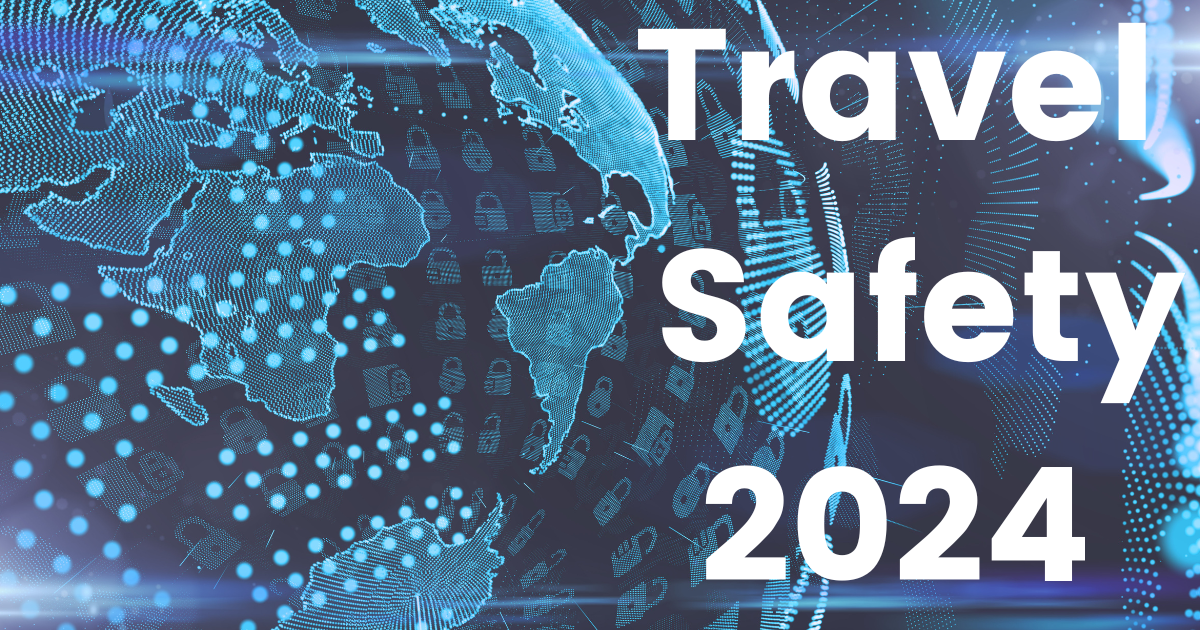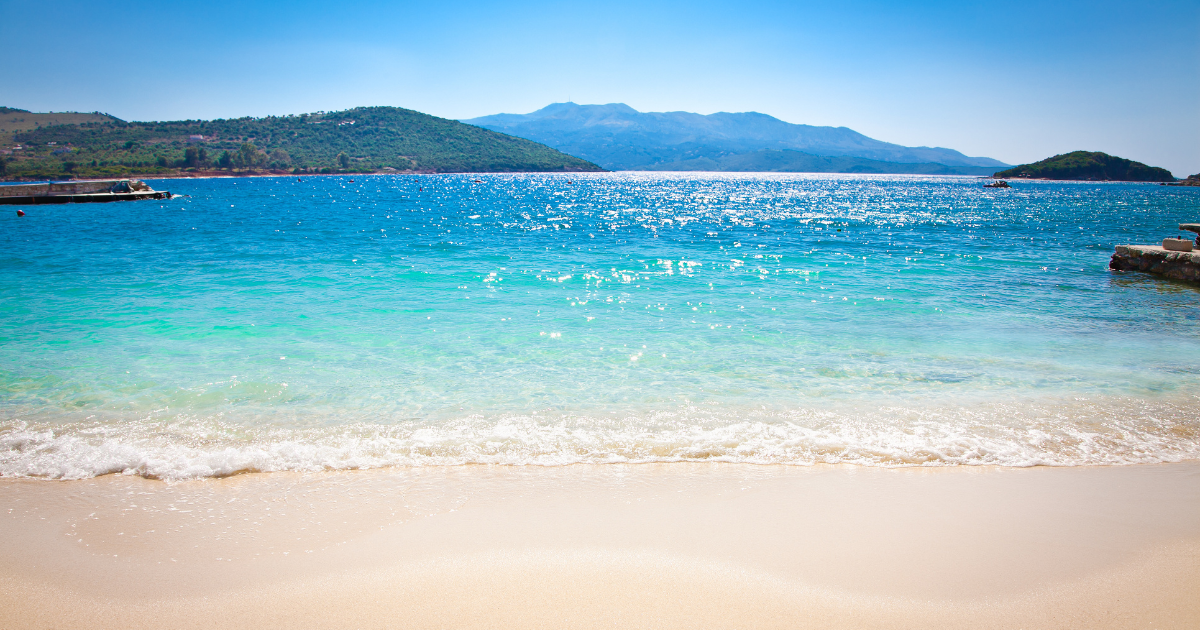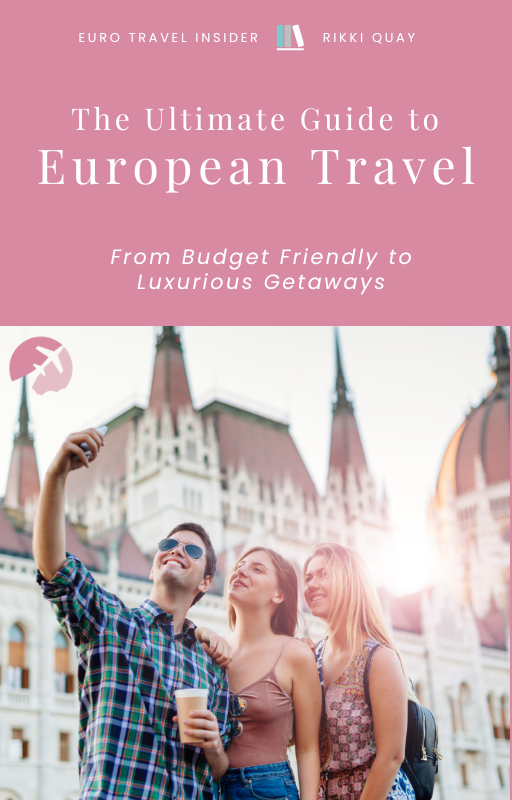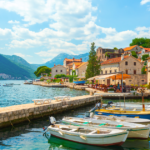Last Updated on June 13, 2024 by Rikki
When it comes to travel safety, the question of … “Is Europe safer than the US for travel?” often arises. In the current global climate, where security is a top concern for travelers and residents alike, it’s essential to analyze crime rates, GPI scores, and societal security to determine which destination offers a safer experience.
When considering travel, safety remains a primary concern for travelers when selecting their destinations. With ongoing conflicts in Ukraine and the Middle East, questions about the safety of visiting Europe have flooded my inbox. Travelers often share the same anxieties about the potential spread of the war, the risk of terrorism, refugee issues, and the prevalence of strikes and protests across Europe.

The media’s tendency to sensationalize events can exacerbate these concerns, making Europe seem more perilous than it truly is.
However, as someone who is presently traveling Europe and plans to continue doing so, backed by many others who travel Europe full-time, I can confidently affirm that Europe is a safe destination to visit.
Today’s media often adheres to the adage “If it bleeds, it leads,” amplifying isolated incidents and portraying them as representative of the entire continent.
These sensationalized reports, exploited by politicians to support their agendas, contribute to a distorted perception of Europe as a turbulent and dangerous place.

However, it’s crucial to remember that Europe is not inherently riskier than many U.S. cities, particularly when it comes to gun violence. In fact, seven of the world’s top ten safest countries are in Europe, while the USA ranks 129th.
Statistically speaking, Europe is safer than ever in terms of terrorism, and as a tourist, you are not at greater risk than in previous years. Misconceptions fueled by media sensationalism should not deter you from experiencing the rich culture and beauty that Europe has to offer.
Recent travels and lived experiences in Europe have shown that the continent is safe to visit. While media coverage may sensationalize isolated incidents, statistically speaking, Europe is as safe, if not safer, than many cities in the US and elsewhere.
In fact, Europe is home to seven out of the world’s top ten safest countries, according to Global Peace Index (GPI) scores (see the Data Index below left.) On the other hand, the US ranks 129th, highlighting the disparity in safety levels. Additionally, incidents of terrorism in Europe have been on the decline, further contributing to its reputation as a secure destination.
However, it’s important to acknowledge that Europe, like any region, has its own set of challenges. Pickpocketing, for example, can be a concern in crowded places and major tourist attractions. Yet, by staying vigilant and taking certain safety precautions, travelers can greatly minimize the risk.
Key Takeaways:
- Europe is statistically as safe, if not safer, than many cities in the US and elsewhere.
- Seven out of the world’s top ten safest countries are located in Europe.
- Incidents of terrorism in Europe have been on the decline.
- Pickpocketing can be a concern in crowded places and major tourist attractions.
- By staying vigilant and taking safety precautions, travelers can minimize the risk.
Safety Tips for Visiting Europe 2024
While Europe is generally safe, it’s important for travelers to be aware of potential risks and take precautions. By following these safety tips, you can make your trip to Europe a secure and worry-free experience.

These tips are best kept in mind not only when traveling to other countries but also whilst you are in your home country.
1. Be mindful of thieves and pickpockets
Thieves and pickpockets often target crowded places, such as major tourist attractions and markets. Stay vigilant and keep an eye on your belongings at all times. Be especially cautious in crowded areas where thieves can easily blend in.
2. Take precautions when using public transit
Public transit can be a convenient way to get around in Europe. However, be cautious of your surroundings and keep your belongings secure. Avoid displaying valuable items and be wary of suspicious individuals.
3. Use ATMs with caution
When using ATMs, make sure you are in a well-lit and secure area. Shield your PIN while entering it, and be aware of anyone standing too close. Check for any suspicious devices attached to the ATM that may be used for skimming your card. Overall it is safer to use an ATM attached to a bank.
4. Carry a passport photocopy
Always carry a photocopy of your passport with you or keep a digital copy on your phone or email. This will be useful in case your passport gets lost or stolen, and can help expedite the replacement process.
Should you find yourself in need of speeding up your U.S. passport application, RushMyPassport offers a premier online U.S. Passport Courier Service widely trusted by many for its efficiency. Opting for their service means you can avoid a trip to the passport office, thereby saving precious time.
5. Never leave drinks unattended
Whether you’re at a bar, restaurant, or social event, never leave your drink unattended. This will help prevent incidents of drink spiking and ensure your personal safety.
6. Obtain travel insurance
Prior to your trip, consider purchasing travel insurance that covers medical emergencies, trip cancellations, and lost or stolen belongings. Travel insurance provides peace of mind and financial protection in case of any unforeseen circumstances.
Remember, while these safety tips can help you mitigate risks, it’s essential to remain cautious and stay informed about the local safety guidelines of your destination. By taking these precautions, you can enjoy your visit to Europe without any major safety concerns.
| Common Safety Tips for Visiting Europe | Benefits |
|---|---|
| Keep an eye on belongings at all times | Prevents pickpocketing and theft |
| Be cautious when using ATMs | Avoid card skimming and fraudulent activities |
| Carry a passport photocopy | Facilitates replacement in case of loss or theft |
| Never leave drinks unattended | Ensures personal safety from drink spiking incidents |
| Obtain travel insurance | Provides financial protection and peace of mind |
The War in Ukraine and Travel Safety
While the war in Ukraine has raised concerns about travel safety in Europe, it’s important to note that the conflict is localized within Ukraine.

Travel to Ukraine itself is not advisable, but neighboring countries like Poland, Slovakia, Hungary, and Romania remain safe for tourists. The war does not impact day-to-day events in other European destinations, allowing travelers to explore without worry.
Even though the war in Ukraine continues, it is crucial to remember that the conflict remains contained within the country’s borders. As a result, tourists can still enjoy the beauty and charm of safe neighboring countries in Eastern Europe, which serve as excellent alternatives for travel.
“While the war in Ukraine has raised concerns about travel safety in Europe, it’s important to note that the conflict is localized within Ukraine.”
Take Poland, for example. This captivating country boasts a rich history, breathtaking landscapes, and vibrant cities such as Warsaw and Krakow. Travelers can immerse themselves in Poland’s culture and heritage while enjoying the safety and tranquility it offers.
Slovakia is another safe and picturesque destination with its stunning natural scenery, quaint villages, and historical sites like Bratislava Castle. Travelers can explore the country’s national parks, indulge in local cuisine, and learn about its fascinating history without worrying about the conflict in Ukraine.
Similarly, Hungary offers a blend of vibrant city life and serene countryside. Budapest, the country’s capital, fascinates visitors with its stunning architecture, thermal baths, and vibrant cultural scene. Travelers can stroll along the Danube River, visit the historic Buda Castle, or relax in one of the famous thermal spas, all while enjoying a safe and peaceful environment.
Romania, known for its enchanting landscapes and medieval castles, is also unaffected by the localized conflict in Ukraine. Visitors can explore Bran Castle, often associated with the legend of Dracula, explore the charming city of Bucharest, or wander through the picturesque countryside of Transylvania, all without compromising their safety.
Safe neighboring countries unaffected by the war in Ukraine:
| Country | Main Attractions |
|---|---|
| Poland | Warsaw, Krakow, Wieliczka Salt Mine |
| Slovakia | Bratislava, High Tatras, Spis Castle |
| Hungary | Budapest, Danube River, Buda Castle |
| Romania | Bran Castle, Bucharest, Transylvania |
These countries offer a wealth of cultural, historical, and natural wonders for travelers to enjoy, all while ensuring a safe and memorable experience. So, while the war in Ukraine may cause some concerns, it is essential to remember that Europe still contains numerous safe and captivating destinations for travelers to explore.
Safest Countries in Europe
When it comes to safety, Europe offers a range of countries that stand out as the safest places to visit.

Whether you’re a seasoned traveler or embarking on your first adventure, these countries prioritize security and provide a safe environment for residents and tourists alike.
According to the Global Peace Index (GPI) scores, the absolute safest countries in Europe include Iceland, Ireland, Denmark, and Austria. These nations have consistently demonstrated low crime rates, societal security, and a high level of peace.
Iceland, known for its stunning natural landscapes, is not only a treasure trove for outdoor enthusiasts but also a remarkably safe destination. With a GPI score of 1.1, the country sets the standard for safety in Europe and beyond.
Ireland, with its rich history and vibrant culture, is another top contender. With a GPI score of 1.396, it provides a safe haven for travelers looking to explore ancient castles, picturesque landscapes, and welcoming pubs.
Denmark, renowned for its bicycle-friendly cities like Copenhagen and its emphasis on happiness, also ranks highly in terms of safety. With a GPI score of 1.355, Denmark offers visitors peace of mind as they explore its charming streets and immerse themselves in Scandinavian culture.
Lastly, Austria, with its stunning Alpine vistas, is a safe and welcoming country for travelers. With a GPI score of 1.291, Austria is known for its efficient infrastructure, rich history, and world-famous musical heritage.
Travelers heading to any of these countries can expect exceptional safety standards, enabling them to fully enjoy their experiences without unnecessary worries. Whether you’re mesmerized by Iceland’s Northern Lights, enchanted by Ireland’s ancient ruins, captivated by Denmark’s design scene, or inspired by Austria’s classical music, these countries provide the ideal setting for a safe and memorable journey through Europe.

Safe and Secure: A Snapshot of the Safest Countries in Europe
| Country | GPI Score |
|---|---|
| Iceland | 1.1 |
| Ireland | 1.396 |
| Denmark | 1.355 |
| Austria | 1.291 |
Solo Travel Safety in Europe
Europe is renowned as one of the safest destinations for solo travelers, making it an ideal choice for first-time adventurers and female travelers. With its rich history, diverse cultures, and stunning landscapes, Europe offers a plethora of experiences that can be enjoyed without major concerns for personal safety.
Decades of travel experiences and statistics demonstrate that safety issues are rare in Europe, providing solo travelers with peace of mind and the freedom to explore independently. While it’s always important to exercise caution and common sense when traveling alone, Europe’s welcoming atmosphere and reliable infrastructure contribute to a secure environment for solo explorations.
Tips for Safe Solo Travel in Europe
- Research: Before embarking on your solo adventure, take the time to research your destination’s safety ratings, local customs, and potential risks. Stay updated on travel advisories and learn about any specific precautions you should take.
- Plan Your Itinerary: Create a well-planned itinerary that includes safe accommodation options, transportation routes, and popular attractions. Having a clear plan can help you navigate unfamiliar territories and reduce the risk of getting lost or finding yourself in potentially unsafe areas.
- Blend In: While embracing different cultures and expressing your individuality is a wonderful part of travel, blending in with the local crowd can help you avoid unnecessary attention and minimize the risk of becoming a target for theft or scams. Dress modestly and observe the local customs and traditions.
- Stay Connected: Keep your loved ones informed about your whereabouts and share your travel plans with someone you trust. Stay connected through phone calls, messaging apps, or social media platforms to maintain a support network and have someone to reach out to in case of emergencies.
- Trust Your Instincts: Trusting your instincts is crucial when traveling solo. If a situation feels uncomfortable or unsafe, remove yourself from it. Intuition can be a valuable tool for keeping yourself out of harm’s way.
- Use Reliable Transportation: When using public transportation, opt for reputable companies and avoid poorly lit or secluded areas. Use licensed taxis or ride-sharing services, and familiarize yourself with the local transportation schedules and routes.
- Be Mindful of Your Belongings: Pickpocketing can occur in crowded places, such as major tourist attractions, markets, and public transit. Keep your valuables secure and within sight at all times. Consider using anti-theft bags or money belts to deter potential thieves.
- Emergency Preparedness: Carry a photocopy of your passport and important documents, leaving the originals stored safely in your accommodation. Familiarize yourself with the local emergency services numbers and have a plan in place in case you need assistance.
- Travel Insurance: It’s essential to have comprehensive travel insurance that covers medical emergencies, trip cancellations, and stolen belongings. Ensure that your insurance policy meets your specific needs and provides adequate coverage for solo travel.

Remember, solo travel can be empowering and life-changing, allowing you to embrace new cultures, meet fascinating people, and discover your own strength and resilience. By following these safety tips and trusting in your abilities, you can embark on a solo European adventure with confidence and peace of mind.
If you’re still in doubt about the safety of solo travel in Europe, take a moment to consider the experiences and insights shared by countless solo travelers who have explored the continent and returned with stories of unforgettable adventures and cherished memories. Don’t let fear hold you back from experiencing the wonders that Europe has to offer.
| Country | Safety Rating |
|---|---|
| Iceland | 9.08 |
| Ireland | 9.15 |
| Denmark | 9.22 |
| Austria | 9.24 |
Conclusion
When comparing travel safety between Europe and the US, it’s evident that Europe offers a comparable, if not safer, travel experience. Despite Europe’s safety reputation being influenced by sensationalized media coverage and misconceptions, the reality is that crime rates and terrorism incidents in Europe are on par, or even lower, than those in the US.
Travelers can feel confident in exploring Europe’s rich heritage, vibrant cities, and diverse landscapes, provided they take basic safety precautions. Europe’s top tourist destinations, such as Paris, London, Rome, and Barcelona, have well-established security measures to ensure the safety of visitors. Additionally, European countries consistently rank among the safest globally, with countries like Iceland, Ireland, Denmark, and Austria leading the way in terms of peacefulness and societal security.
By being aware of their surroundings and taking common-sense precautions like keeping a close eye on belongings, avoiding unattended drinks, and using reliable transportation options, travelers can enjoy all that Europe has to offer without undue worry. Europe’s history, culture, and natural beauty await those seeking a safe and enriching travel experience.
If you have safety concerns about traveling to Egypt, Jordan, Lebanon, or Türkiye at the moment, this article offers valuable insights.
Note
Please be aware that the information in this article is accurate as of its publication date. It is highly recommended that travelers confirm their specific circumstances by reaching out to their respective embassies and keeping abreast of the latest news updates for any changes in travel advisories.
For American citizens, it is advisable to register with the United States State Department to remain updated on current global events. Additionally, remember to check in regularly during your journey to stay informed about ongoing situations worldwide.


















